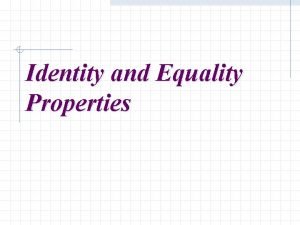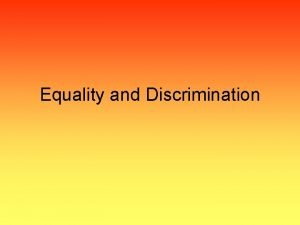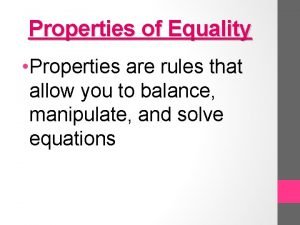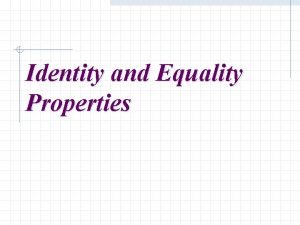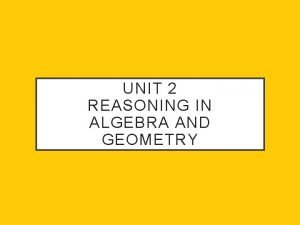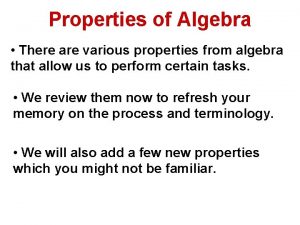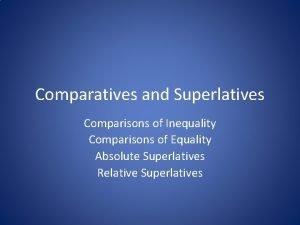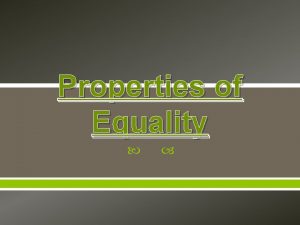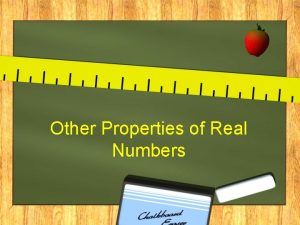Identity and Equality Properties Identity and Equality Properties















- Slides: 15

Identity and Equality Properties

Identity and Equality Properties • Properties refer to rules that indicate a standard procedure or method to be followed. • A proof is a demonstration of the truth of a statement in mathematics. • Properties or rules in mathematics are the result from testing the truth or validity of something by experiment or trial to establish a proof. • Therefore, every mathematical problem from the easiest to the more complex can be solved by following step by step procedures that are identified as mathematical properties.

Identity Properties • Additive Identity Property • Multiplicative Identity Property of Zero • Multiplicative Inverse Property

Additive Identity Property § For any number a, a + 0 = 0 + a = a. § The sum of any number and zero is equal to that number. § The number zero is called the additive identity. § Example: If a = 5 then 5 + 0 = 0 + 5 = 5.

Multiplicative Identity Property § For any number a, a 1 = 1 a = a. § The product of any number and one is equal to that number. § The number one is called the multiplicative identity. § Example: If a = 6 then 6 1 = 1 6 = 6.

Multiplicative Property of Zero § For any number a, a 0 = 0 a = 0. § The product of any number and zero is equal to zero. § Example: If a = 6, then 6 0 = 0 6 = 0.

Multiplicative Inverse Property § For every non-zero number, a/b, § Two numbers whose product is 1 are called multiplicative inverses or reciprocals. § Zero has no reciprocal because any number times 0 is 0. § Example:

Equality Properties • Equality Properties allow you to compute with expressions on both sides of an equation by performing identical operations on both sides of the equal sign. The basic rules to solving equations is this: * Whatever you do to one side of an equation; You must perform the same operation(s) with the same number or expression on the other side of the equals sign. • Substitution Property of Equality • Addition Property of Equality * • Multiplication Property of Equality

Substitution Property of Equality § If a = b, then a may be replaced by b in any expression. § The substitution property of equality says that a quantity may be substituted by its equal in any expression. § Many mathematical statements and algebraic properties are written in if-then form when describing the rule(s) or giving an example. § The hypothesis is the part following if, and the conclusion is the part following then. § If 8 + 4 = 7 + 5; since 8 + 4 = 12 or 7 + 5 = 12; § Then we can substitute either simplification into the original mathematical statement.

Addition Property of Equality § If a = b, then a + c = b + c or a + (-c) = b + (-c) § The addition property of equality says that if you may add or subtract equal quantities to each side of the equation & still have equal quantities. § In if-then form: § If 6 = 6 ; then 6 + 3 = 6 + 3 or 6 + (-3) = 6 + (-3).

Subtraction Property of Equality § If a = b, then a -c= b -c or a - (-c) = b - (-c) § The subtraction property of equality says that if you may subtract equal quantities to each side of the equation & still have equal quantities. § In if-then form: § If 6 = 6 ; then 6 - 3 = 6 -3 or 6 - (-3) = 6 - (-3).

Multiplication Property of Equality If a = b, then ac = bc The multiplication property of equality says that if you may multiply equal quantities to each side of the equation & still have equal quantities. In if-then form: § If 6 = 6 ; then 6 * 3 = 6 * 3.

Division Property of Equality The Division Property of Equality states that if The Division Property of you divide both sides of an equation by the same Equality states that if you divide both nonzero number, the sides remain equal sides of an equation by the same nonzero number, the sides remain equal If 6=6, then 6/3=6/3

Associative Property The associative property states that you can add or multiply regardless of how the numbers are grouped. By 'grouped' we mean 'how you use parenthesis'. In other words, if you are adding or multiplying it does not matter where you put the parenthesis. Add some parenthesis any where you like

Commutative Property is the one that refers to moving stuff around. For addition, the rule is "a + b = b + a"; in numbers, this means 2 + 3 = 3 + 2. For multiplication, the rule is "ab = ba"; in numbers, this means 2× 3 = 3× 2
 What is the additive identity
What is the additive identity Identity property of equality
Identity property of equality Substantive equality vs formal equality
Substantive equality vs formal equality Cedaw article
Cedaw article Reflexive property of equality
Reflexive property of equality Identity property?
Identity property? Commutative property of equality
Commutative property of equality Reflexive property of equality
Reflexive property of equality Subtraction property of equality example
Subtraction property of equality example A.backtoschool
A.backtoschool Multiplicative identity
Multiplicative identity Commutative identity associative distributive properties
Commutative identity associative distributive properties Difference between intensive and extensive properties
Difference between intensive and extensive properties Chemical and physical properties
Chemical and physical properties Comparative of inequality
Comparative of inequality Care certificate standard 4
Care certificate standard 4
